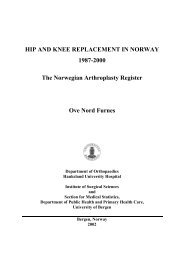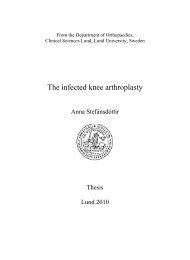E-Book German Arthroplasty Register EPRD - EAR - EFORT
E-Book German Arthroplasty Register EPRD - EAR - EFORT
E-Book German Arthroplasty Register EPRD - EAR - EFORT
Create successful ePaper yourself
Turn your PDF publications into a flip-book with our unique Google optimized e-Paper software.
6<br />
The <strong>German</strong><br />
<strong>Arthroplasty</strong> <strong>Register</strong><br />
(<strong>EPRD</strong>)<br />
Artificial joint replacement is<br />
one of the biggest success<br />
2. Background<br />
stories of modern medicine.<br />
Pain, functional disorders and<br />
restricted mobility can be treated effectively and durably<br />
in particular in the hip and knee joint. In the eyes of the<br />
public joint replacement has meanwhile become a sort<br />
of standard intervention that is associated with high<br />
expectations. In many studies the success rate in terms<br />
of implant survival is reported to be approximately 95 %<br />
at 10 years.<br />
Hip and knee replacement rank among the most common<br />
surgical procedures throughout <strong>German</strong>y. In 2010,<br />
for instance, in summary about 390,000 joint replacements<br />
were performed in <strong>German</strong>y. Of these 157,712<br />
interventions were total hip arthroplasties, 24,948 hip<br />
revision surgeries, and about 50,000 hip replacements<br />
after femoral neck fractures. In the same year 146,233<br />
knee prostheses were implanted and 12,215 artificial<br />
knee joints revised (1).<br />
The prevalence of both hip and knee arthroplasty<br />
interventions is exceptionally high in <strong>German</strong>y (2; 3). In<br />
view of an increasingly aging population several authors<br />
expect a further increase in joint replacement surgery in<br />
Western industrialised nations (4-6).<br />
As evaluations from the Finnish <strong>Register</strong> have shown, a<br />
considerable proportion of revision surgeries actually<br />
become necessary not only 10 to 15 years after implantation,<br />
but sometimes far earlier (7). These findings are also<br />
true for <strong>German</strong>y: in 2010 the revision rates even during<br />
primary in-patient stay were 1.6 % for primary hip prostheses,<br />
5.6 % for hip revisions, 1.4 % for knee replacements,<br />
and 3.4 % for knee revision surgeries.<br />
In spite of the – relatively speaking – low failure rates,<br />
due to the high number of implantations a very large<br />
number of patients actually have to undergo serious revi-<br />
Structure, Procedures and Organisation<br />
sion surgery, many of them at an advanced<br />
age with additional general risk factors.<br />
Apart from the personal distress due to pain<br />
and lack of mobility, there are also associated<br />
annual costs of about 370,000,000 euros<br />
that have to be taken into account, based<br />
on an estimate of 10,000 euros per revision<br />
surgery.<br />
Starting in 1979, Sweden certainly has<br />
the longest experience with arthroplasty<br />
<strong>Register</strong>s run with significant involvement of<br />
the National Orthopaedic Society. Since the<br />
introduction of the <strong>Register</strong> the revision rate<br />
has been reduced decisively, i.e. by almost<br />
half. The main effect was already observed<br />
early after launch of the <strong>Register</strong> (8;9).<br />
Multifactorial parameters, such as the type<br />
of prosthesis, surgical technique, but also<br />
patient-specific factors are supposed to<br />
affect implant survival times until revision<br />
surgery. The <strong>German</strong> <strong>Arthroplasty</strong> <strong>Register</strong><br />
will allow for in-depth analysis of the effects<br />
of these variables.<br />
On a global scale, the necessity of <strong>Arthroplasty</strong><br />
<strong>Register</strong>s is recognised by an increasing<br />
number of countries (10). <strong>Arthroplasty</strong><br />
<strong>Register</strong>s have already been established<br />
in various Scandinavian countries (11;12),<br />
Australia (13), Canada (14) and New Zealand,<br />
but also the Orthopaedic Societies of the<br />
USA, Great Britain, France and South Africa<br />
support the development and maintenance<br />
of <strong>Arthroplasty</strong> <strong>Register</strong>s (15). Particular<br />
efforts in promoting a National <strong>Arthroplasty</strong><br />
<strong>Register</strong> are presently being made in the<br />
USA (16). However, the results from foreign<br />
<strong>Register</strong>s are not exactly transferable to the<br />
<strong>German</strong> situation (17).









